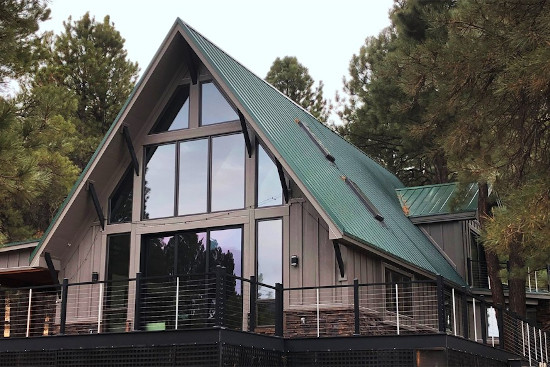Original article by: BUILDER Online
Learn why going dual fuel helped this influential project achieve the owner’s comfort, resilience, and ultra-efficiency goals.
Bill Owens has been closely involved with the green building movement for more than two decades.
As a highly respected remodeler and active member in the leadership of the National Association of Home Builders, Owens has kept himself on the leading edge of energy-efficient construction technologies. So it was only natural that when he remodeled his own “forever home,” Owens designed the home to be zero energy ready, with a predicted Home Energy Rating System (HERS) Index rating under 30.
Owens is president of Owens Construction, a design-build remodeling firm in Worthington, Ohio, but his new home is a renovation of a 1970s mountain chalet outside of Flagstaff, Arizona. Contrary to the common perception of Arizona, the home is in a dry, high mountain desert environment at 7,000 feet of altitude, so it experiences extreme temperatures and an average of 100 inches of precipitation each year, mainly in snow.

That climate, combined with the home’s remote, semi-rural location, led to Owens busting another common perception — that zero energy homes must be all-electric. In fact, to achieve the comfort, resilience, and efficiency Owens had in mind for his dream home, going dual fuel with propane created an ideal energy solution.
Ultra-efficient technologies and materials
The project includes many of the technology and building material hallmarks of modern ultra-efficient homes.
Owens used continuous 2-inch foam insulation on the outside of the house, along with a reflective barrier that reduces heat flow. In remodeling a home with existing 2x4 construction, the team used a combination of open-cell and closed-cell spray foam insulation. That included 4–5 inches of closed-cell spray foam around the existing crawl space and about 8 inches of spray foam in the attic to achieve close to an R-50 insulation value. He went back to pay special attention to reduce air infiltration around windows and used energy-recovery ventilators to provide efficient ventilation for a home with about 1 1/2 air changes per hour.

With a home that well-insulated, a high-efficiency mini-split heat pump system can handle the heating load in moderately cold conditions. But temperatures on the mountain can drop as low as -30 degrees Fahrenheit. Plus, Owens didn’t want his standby generator to be huge enough to run all the heat pumps during an outage. A hybrid heating solution with Goodman propane furnaces for the first floor and crawl space was an ideal solution.
“I just didn’t want the house freezing up on those cold nights,” Owens says. The crawl space furnace also heats up the hard floors above the crawl space, which are necessary in the dusty Arizona environment.

With backup propane heating in place, Owens could install a right-sized propane standby generator to handle the electrical needs of the furnaces, water pumps, refrigerator, and smart home features such as the smart water valve protecting against leaks.
To see how propane tankless water heating and cooking affected the home’s zero energy ready design, check out the full article on Propane.com.

